
Mastering Possibilities: The Indispensable Role of First Conditional Worksheets in English Language Learning
English, as a global lingua franca, empowers individuals to communicate across cultures and navigate diverse professional and personal landscapes. A cornerstone of effective communication in English lies in mastering its intricate grammatical structures, among which the first conditional holds a particularly vital position. It allows speakers to discuss realistic future possibilities and their likely outcomes, a concept crucial for planning, making predictions, and engaging in everyday conversations. While theoretical explanations of grammar are essential, true mastery comes through application and practice. This is where First Conditional Worksheets emerge as an indispensable tool in the arsenal of both educators and self-learners, providing structured, targeted practice that solidifies understanding and builds confidence.
The first conditional, often referred to as the "real conditional," deals with situations that are real or highly probable in the present or future. Its basic structure is straightforward: "If + subject + simple present verb, subject + will/won’t + base form of verb." For instance, "If it rains tomorrow, I will bring my umbrella," or "If she studies hard, she will pass the exam." This structure is deceptively simple; learners often struggle with correct tense usage in both clauses, proper comma placement, and the nuanced understanding of when to apply this specific conditional. This is precisely why well-designed First Conditional Worksheets are not just supplementary materials, but foundational elements in the learning process.
The Foundational Role of First Conditional Worksheets
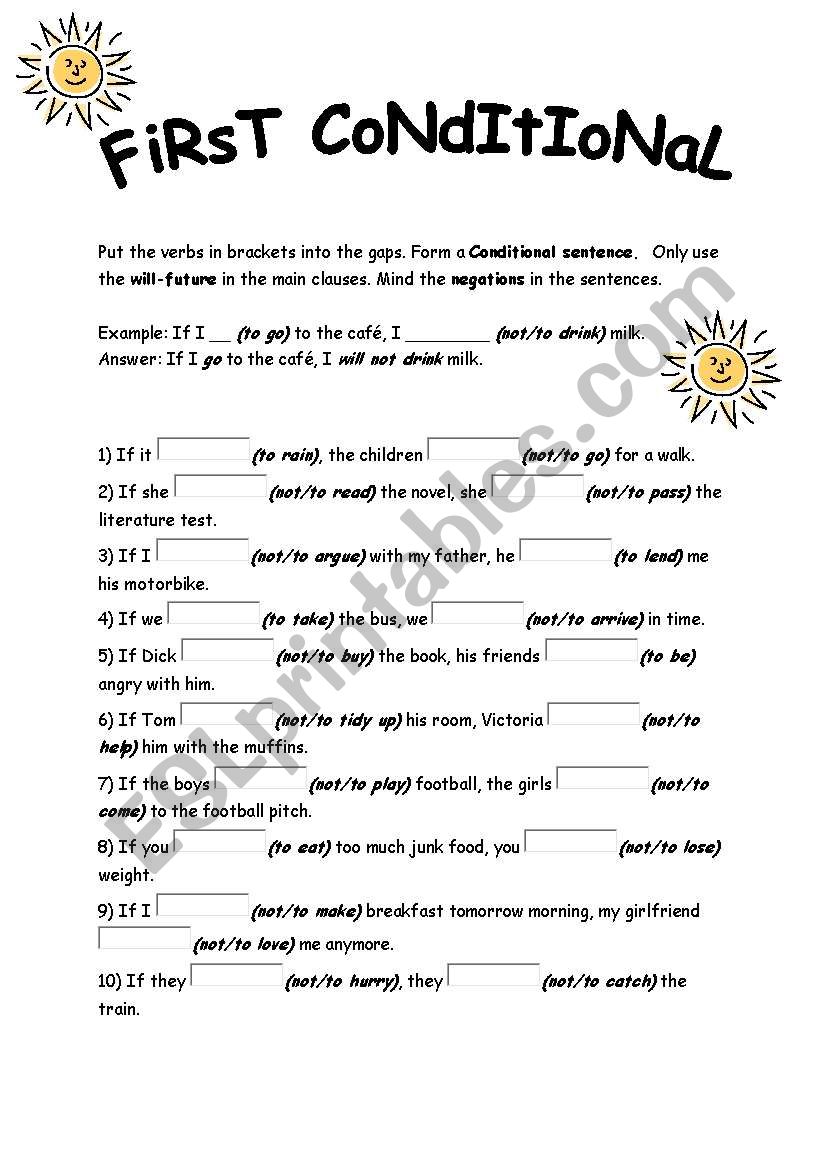
Worksheets serve as a bridge between passive knowledge acquisition (listening to explanations) and active knowledge application (using the grammar correctly). They transform abstract rules into concrete exercises, allowing learners to experiment, make mistakes, and learn from them in a low-stakes environment. Here’s why they are so crucial:
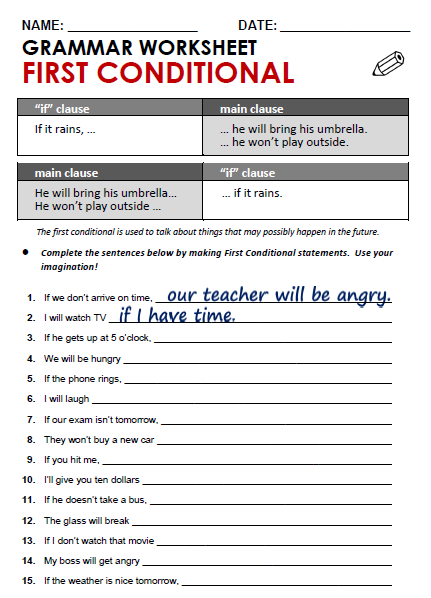
- Reinforcement and Repetition: Grammar rules, particularly those involving specific tense combinations like the first conditional, require repeated exposure and application to stick. Worksheets offer numerous opportunities to practice the same structure in varied contexts, helping to embed the pattern into the learner’s linguistic memory.
- Active Learning: Instead of passively listening, learners actively engage with the material by filling in blanks, matching clauses, or constructing sentences. This active engagement enhances retention and deeper understanding.
- Identification of Gaps: As learners work through exercises, they – and their instructors – can quickly identify specific areas of confusion or common errors. Is it the simple present in the "if" clause? The "will" in the main clause? Or understanding the distinction between the first and other conditionals? Worksheets pinpoint these weaknesses for targeted intervention.
- Building Confidence: Successfully completing exercises provides a sense of accomplishment, reinforcing correct usage and building the learner’s confidence to use the first conditional in spontaneous communication.
- Differentiated Instruction: Worksheets can be tailored to various proficiency levels, offering simpler exercises for beginners and more complex, open-ended tasks for advanced learners, ensuring that every student receives appropriate challenges.

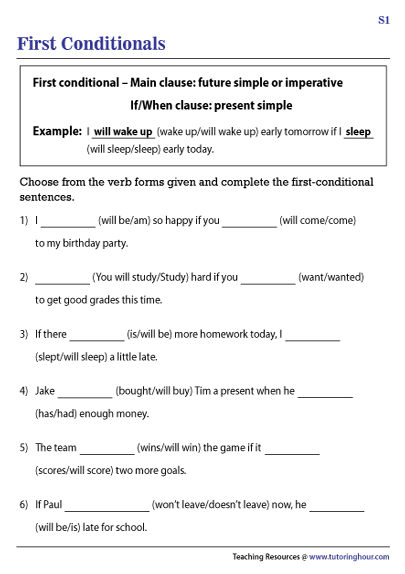

Types of First Conditional Worksheets and Their Pedagogical Value

The effectiveness of First Conditional Worksheets lies in their diversity. Different types of exercises target different aspects of language learning, from form to meaning to use.
-
Gap-Fill / Fill-in-the-Blanks:
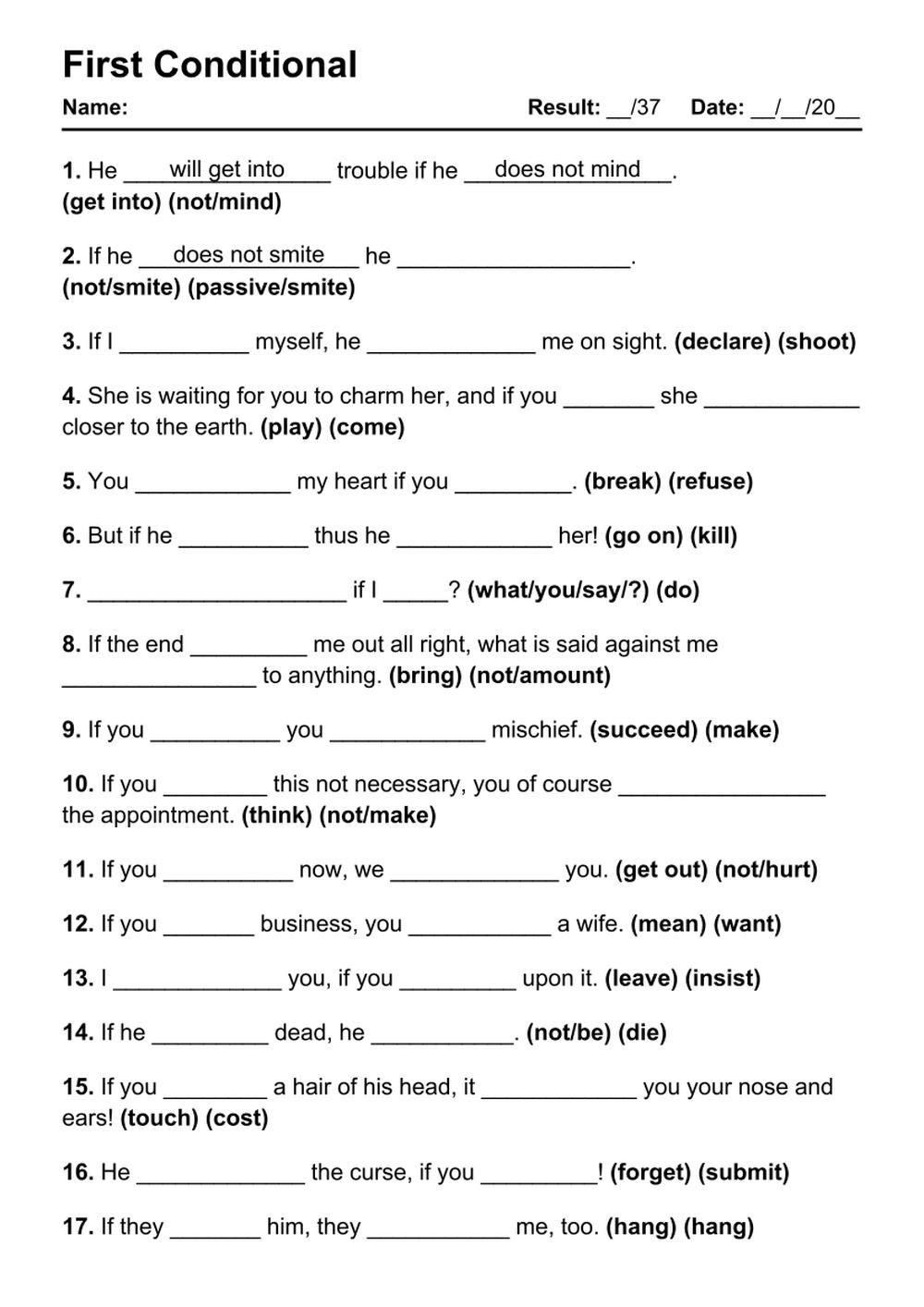
- Description: These are perhaps the most common type. Sentences are provided with missing verbs in either the "if" clause, the main clause, or both. Learners must supply the correct form of the verb (e.g., "If I (study) hard, I (pass) the exam.").
- Value: Excellent for reinforcing the basic form (simple present and "will" + base verb) and ensuring learners correctly identify the tense required in each clause.
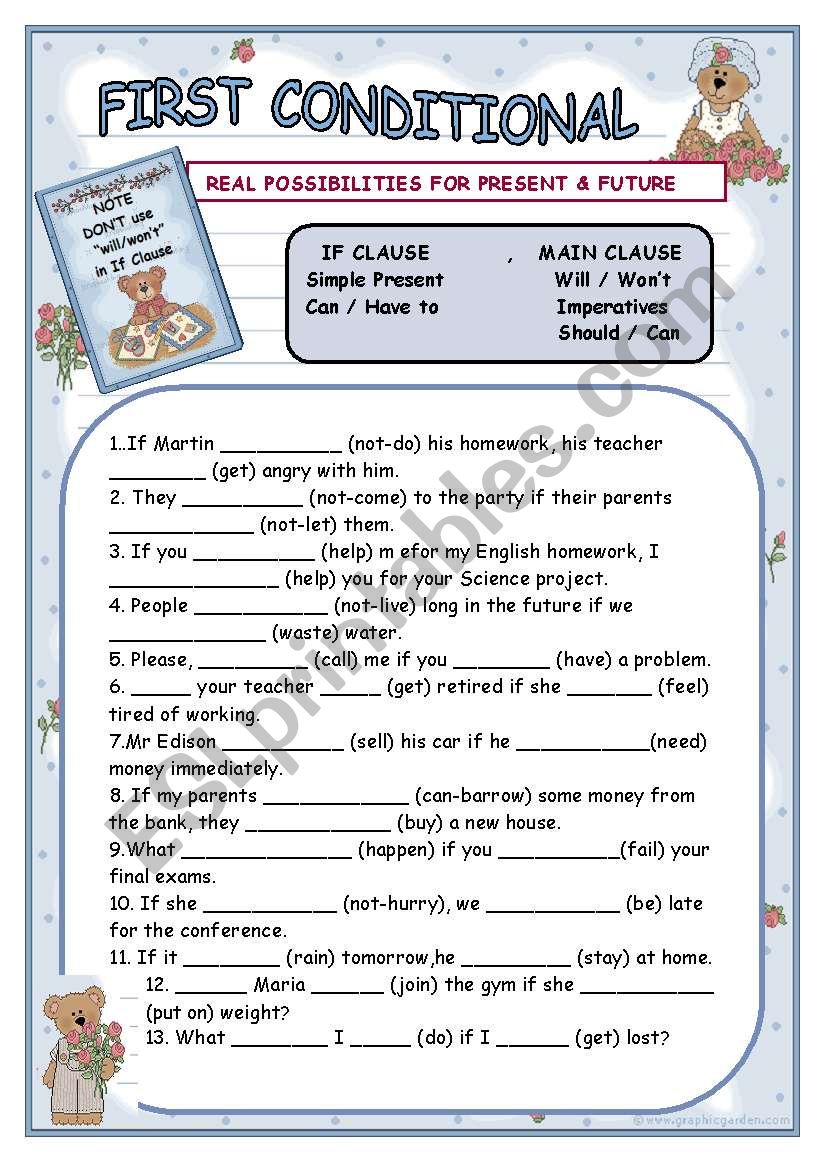
-
Matching Exercises:
- Description: Learners are given two columns: one with "if" clauses and another with corresponding main clauses. They must match them correctly to form logical first conditional sentences.
- Value: Develops an understanding of cause-and-effect relationships inherent in the first conditional and encourages contextual comprehension.
-
Sentence Unscramble / Reordering:
- Description: Scrambled words or phrases are provided, and learners must arrange them to form grammatically correct first conditional sentences.
- Value: Reinforces word order, especially the position of "if" and the two clauses, and helps learners internalize sentence structure.
-
Error Correction:
- Description: Sentences containing grammatical errors related to the first conditional are presented, and learners must identify and correct them. (e.g., "If she will arrive late, we start without her.")
- Value: Promotes critical thinking about grammar rules, encouraging learners to actively identify deviations from the correct form rather than just passively applying it.
-
Sentence Transformation:
- Description: Learners are given a sentence in a different tense or structure and asked to rewrite it as a first conditional sentence. (e.g., "It might rain, so I’ll take an umbrella." -> "If it rains, I will take an umbrella.")
- Value: Enhances flexibility in using the structure and helps learners see how different grammatical forms can convey similar meanings.
-
Picture Prompts / Scenario-Based Exercises:
- Description: Worksheets include images or short scenarios (e.g., a cloudy sky, someone looking tired) and ask learners to create first conditional sentences based on what they see or read. (e.g., Picture of a person yawning: "If he is tired, he will go to bed early.")
- Value: Encourages creative application, connects grammar to real-world situations, and develops communicative competence.
-
Open-Ended Questions / Conversation Prompts:
- Description: Learners are given prompts (e.g., "What will you do if you win the lottery?", "What will happen if global warming continues?") and asked to write or discuss their answers using the first conditional.
- Value: Moves beyond rote practice into more communicative and personalized use, fostering fluency and encouraging the expression of personal ideas.
-
Chain Stories / Collaborative Activities:
- Description: One learner starts a first conditional sentence, and another adds a new conditional sentence based on the first one’s outcome. (e.g., "If I study hard, I will pass the exam." -> "If I pass the exam, I will celebrate.")
- Value: Promotes collaborative learning, active listening, and extended use of the structure in a dynamic context.

Designing and Implementing Effective First Conditional Worksheets
The utility of a worksheet is directly proportional to its design and how it’s integrated into the learning process.
- Clear Instructions: Ambiguous instructions can hinder learning. Ensure that what is expected from the learner is crystal clear, perhaps with an example.
- Gradual Difficulty (Scaffolding): Begin with simpler, controlled exercises (e.g., gap-fills with given verbs) and progressively move towards more challenging, open-ended tasks (e.g., creating sentences from scratch, error correction). This scaffolding ensures learners build confidence at each step.
- Contextual Relevance: Sentences and scenarios should be relatable and meaningful to the learners’ lives. Using situations they might encounter in daily life (weather, plans, health, studies) makes the grammar feel more practical and memorable.
- Variety within a Set: A single worksheet or a set of worksheets should ideally incorporate a mix of exercise types to keep learners engaged and to target different learning skills.
- Visual Appeal: Well-organized layouts, clear fonts, and appropriate use of images or icons can make worksheets more inviting and less intimidating, especially for younger learners or those with visual learning preferences.
- Answer Keys: For self-learners, comprehensive answer keys are non-negotiable for immediate feedback and self-correction. For classroom use, they allow for quick checking and peer correction.
- Integration into Lesson Plans: Worksheets should not be standalone activities. They are most effective when used as part of a larger lesson cycle:
- Presentation: Explain the grammar rule.
- Controlled Practice: Use worksheets for guided, structured practice with immediate feedback.
- Communicative Practice: Transition to speaking or writing activities that require the use of the first conditional, allowing learners to apply what they’ve practiced in more authentic contexts.
- Review: Revisit worksheets or similar exercises periodically to ensure retention.
Where to Find and Create First Conditional Worksheets
The digital age has made a plethora of resources available.
- Online ESL Platforms: Websites like ESLprintables.com, BusyTeacher.org, British Council LearnEnglish, and many others offer thousands of free, downloadable First Conditional Worksheets created by educators worldwide.
- Textbooks and Workbooks: Traditional English language textbooks invariably include dedicated sections and exercises on the first conditional.
- Teacher-Made Materials: Experienced teachers often create customized worksheets to address specific needs of their students, incorporating relevant cultural contexts or current events.
- AI Tools: Advanced AI language models can now generate customized exercises based on specific parameters, though human review is always recommended for accuracy and pedagogical soundness.
In conclusion, the first conditional is a fundamental grammatical structure that enables effective communication about future possibilities. While its form is relatively simple, its nuanced application requires dedicated practice. First Conditional Worksheets are not just supplementary materials; they are vital tools that facilitate active learning, reinforce understanding, identify learning gaps, and build the confidence necessary for learners to spontaneously and accurately use this crucial grammatical structure. By embracing a variety of worksheet types and integrating them thoughtfully into the learning process, educators and learners alike can unlock the full potential of this powerful grammatical concept, paving the way for greater fluency and communicative competence in English.
